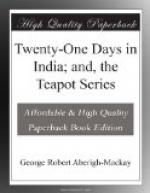No. 13
THE EURASIAN
In November, 1879, when this “Study in chiaro-oscuro” was published, renewed attention was being directed to the Eurasian community in India, mainly by the discussions in all circles aroused by the publication of the late Archdeacon Baly’s Bengal Social Science Association Paper of May in the same year, which dealt with the employment, inter alia, of Europeans of mixed parentage in India; a question which still engages the anxious consideration of many Indian statesmen. Ali Baba’s “Study” is not an ill-natured summary of the widespread discussions of 1879, but indeed as far back as 1843, the late John Mawson in his paper, “The Eurasian Belle,” which first appeared in the Calcutta newspaper, The Bengal Hurkaru, had approached the social and domestic side of the question, and to some extent may be said to have anticipated Ali Baba.
NOS. 14 AND 17
THE VILLAGER AND THE SHIKARRY
Both of these sketches are examples of what maybe termed Ali Baba’s contemplative mood, the villager’s life being revealed to us in all its pathos and interest, otherwise than through an atmosphere of statistics and reports—the daily life of probably two hundred million of the inhabitants of India.
Aberigh-Mackay early showed in his book “A Manual of Indian Sport,” which, in addition to collecting in small compass lessons taught by many a noted Indian hunter, contains a great deal of original matter useful to every would-be sportsman, that he was well fitted to depict “The Shikarry” in correct and graphic manner and from actual personal knowledge.
NOS. 15 AND 16
THE OLD COLONEL AND THE CIVIL SURGEON
“The Old Colonel” and “The Civil Surgeon,” p. 123, are both types of characters that have since practically ceased to exist in India, although fairly numerous in the 1870’s.
“The Old Colonel,” a relic of the great changes caused by the disappearance of many regiments during the Indian Mutiny, and the alterations in Army organisation due to the introduction of the “Staff corps” system, has disappeared from the scene, having long since attained the pensioned rank for which he was ripening when depicted by Ali Baba.
As regards “The Civil Surgeon,” an entirely new state of conditions has altered him also. Even, however, in Ali Baba’s time it could not be said—as it was “long ago”—that a medical officer intended for an Indian career, in order to become perfectly qualified need only sleep one night on a medicine chest.
All the same, to those of us who can look back to life in India forty or fifty years ago, there will surely arise visions of many genial old colonels and doctors, full of good stories and much sympathy in health or sickness for those just entering upon an Indian career.




